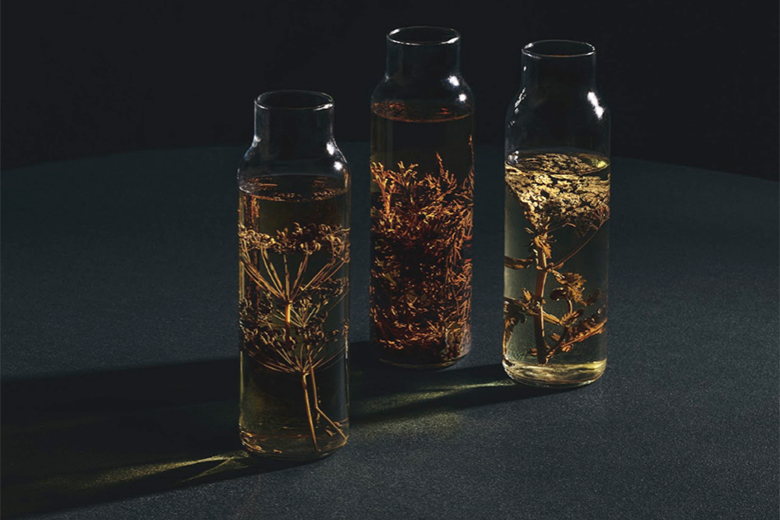
I descend into Aska’s cozy cellar lounge on a snowy February afternoon to meet GM and beverage director Rachael Pack. There are several tables and a small bar that’s lined with more than a dozen glass bottles. One’s filled with vibrant red lingonberries and another with a whole dead, pale langoustine—which floats in a bottle like some kind of science experiment—that grabs my attention.
Those mysterious bottles of aquavit are why I’m visiting. Aquavit has been prominent in Scandinavian culture since the 15th century, and it’s made from just three ingredients: 1) neutral grain spirit 2) infusing agent and 3) time. With time, the alcohol and infusing agent become more than the sum of their parts and often take on surprising new flavors and textures. This was the case with Aska’s black walnut aquavit that was forgotten about for eight months. When it was rediscovered, it had transformed into an intoxicating, nutty, velvety black liquid.
Read more: Meet New York’s Nut Evangelist
In May 2018, a bright red rhubarb sorbet graced the menu. Instead of discarding unused white parts, Rachael made rhubarb aquavit. Come spring, she’ll discard those original pieces and add fresh red rhubarb from this 2019 season to get a beautiful red hue, plus a layer of freshness and complexity. Aska’s luxurious and pungent white truffle aquavit and pine mushroom aquavit were born from that same zero-waste ethos.
Executive sous chef Myles Moody ducks into abandoned lots and scopes out city parks for indigenous New York plants like mugwort, Queen Anne’s lace, rosehip, chickweed, barberries and lovage. Crush up Linden blossoms between your fingers to release their perfume, and it becomes obvious why you would use these local botanicals in spirits the same way juniper is used in gin, and wormwood in absinthe. Lighter, floral aquavits made from delicate ingredients like fennel blossom, honey and wisteria leave you wanting more, making a great aperitif. Hardier, woodsy varieties are grounding, like the pine sap aquavit—it’s super savory with a blast of bitterness at the end, making it a perfect digestif after eating multiple courses.
Read more: How to Make Vermouth with Foraged Ingredients
The Douglas fir aquavit embodies that snowy February winter day. “I’m from Utah, so this one reminds me of home,” Rachael says, “You have the pine aroma, along with a subtle vodka burn that’s like snow slapping you in the face when you’re skiing.” They serve the Douglas fir aquavit with green juice (made in-house with red apple, sorrell and Douglas fir) as a playful yet elegant cocktail.
Guests can combine the liquids for a DIY cocktail or sip them back and forth according to their personal preferences (the langoustine one is reminiscent of a seafood bisque in case you’re curious). The aquavit itself is strong, so the next step is incorporating them into cocktails (think martinis and elevated “vodka soda” highballs). They’re constantly experimenting, so you should stop by to see where their tinkering leads them next.



